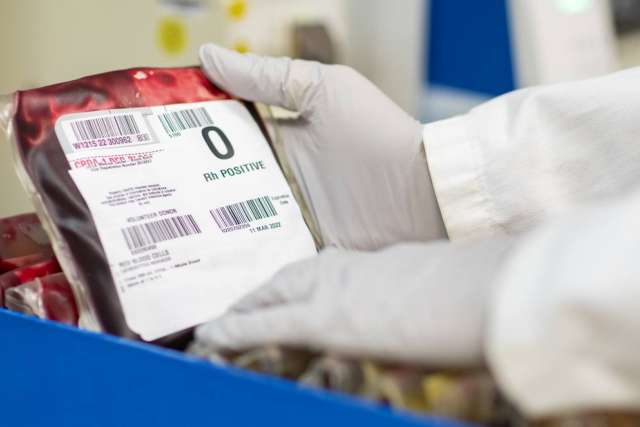Photo: Blood donations at Ronald Reagan UCLA Medical Center on Tuesday. Feb. 8, 2022. (Photo by Joshua Sudock | UCLA Health)
We take for granted that when we get sick, doctors will be available to treat us. And if we need blood, blood banks will have it ready.
But donors provide the units of blood at hospitals and blood banks around the country and across the globe. If there aren’t enough donors, there won’t be enough blood.
The nation is emerging from its worst blood shortage in a decade. The COVID-19 pandemic shut down blood drives and many regular donors have stayed home to avoid contracting the virus, leaving blood supplies perilously low.
“The ability to collect has diminished significantly and has yet to fully recover at the national level,” says Alyssa Ziman, MD, medical director of transfusion services for UCLA Health.
Supplies of blood need constant replenishment. Donated blood supports patients through surgeries and traumatic injuries. People injured in car crashes could need multiple units of blood in the emergency department. Complex transplant surgeries can require as many as 50- to 100 units, Dr. Ziman says.
There has been a particularly significant drop in donations from young people, Dr. Ziman says. Many teenagers have their first experience donating blood at an on-campus blood drive in the high school gymnasium. But under remote learning for more than a year, those drives haven’t been held.
“We may be having trouble connecting to potential donors for whom the internet and social media are the main forms of news and information,” Dr. Ziman says. “And people don’t appreciate that it’s as simple as giving an hour of your life to save someone’s life.”
Who can donate blood and how does it work?
Any healthy person age 17 or older (16 years of age with parental consent) who weighs more than 110 pounds can donate blood. The whole process takes about an hour, but the actual donation only lasts 10 to 15 minutes. Other than a quick needle stick, it’s usually relatively easy and painless.
“Donor safety is our priority,” says Dr. Ziman, “and that the blood we collect will be safe for patients.”

Donors can give whole blood or platelets, which is a more time-consuming process. Platelets are blood cells that are essential to clotting, Dr. Ziman explains, and are given to patients on chemotherapy or with blood malignancies.
To donate platelets, volunteers sit for two hours with a needle in each arm. Blood is extracted, pulled into a machine that removes the platelets, and then returned to the donor.
Though donated blood can remain refrigerated for 42 days, platelets have a very short shelf life: just five days.
“We are constantly collecting platelets to ensure we have inventory for patients,” Dr. ZIman says. “We use about 35 to 40 units a day."
Eight weeks is the minimum time required between whole blood donations so red blood cells have time to replenish. Individuals can donate platelets more frequently and up to 24 times per year.
Paying it forward
After a devastating motorcycle crash in 2014, former UCLA Health patient Brandon Levine received 207 units of red blood cells, plasma and platelets — about 20 times the average person’s blood volume, almost 25 gallons in all.
Levine was hospitalized for two months. After recovering, he committed to giving back the blood that saved his life. He donates every eight weeks.
“There are a million things I’d rather be doing,” Levine says. “But whatever – it’s one day, not even 12 times a year. You just go and do it and suck it up.”
It will take more than 33 years of regular donations for Levine to return all 207 units.
One of his friends was also inspired to donate every eight weeks. They send each other photos every time they go to the donation center, Levine says.
“It’s a hard ask, you know: Go in and stick a big needle in your arm and give a pint of blood,” he says. “But I’ve inspired a couple of people to do it.”
Levine and the blood donors who helped save his life met in person at a special event several years ago. Seeing real people whose lives have been affected by blood donation can be a powerful motivator for future donors, Dr. Ziman says.
“When you see the humanity about it,” she says, “that makes the difference.”
To learn more about donating blood or platelets, visit the UCLA Blood & Platelet Center.




